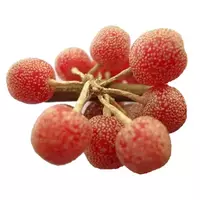Shepherd silver

Silverberry or Shepherd argentea is a small shrub that belongs to the Loch family. Researchers believe that the region of North America can be considered the birthplace of the plant. Currently, silverware in the wild grows mainly in Canada, as well as in the United States. It is worth noting that silverware is resistant to sharp temperature changes and climate changes.
In addition, it is worth paying special attention to the fact that the plant grows, as a rule, in climatic zones, with pronounced seasonality. This means that the plant perfectly tolerates both hot summers and cold and frosty winters. In our latitudes, silver does not grow in the wild. However, the buffalo berry (the popular name for the plant) is successfully cultivated by domestic amateur gardeners. In the United States, shepherd berries are called Nebraska currants, bison or rabbit berries.
They distinguish the main species of plants that grow perfectly in our climate - silverware and Canadian. The silverware received its original name thanks to the director of the Liverpool Botanical Garden, which is located in England. The discoverer of the plant was the botanist Thomas Natol, who discovered the patronage in 181
8. The scientist named the new species after his friend and part-time director of the Botanical Garden, John Shepherd.
It is noteworthy that for quite a long time the plant was not used in any way, although the fruits of silverberry can be eaten. Almost a hundred years later, in 1904, the first stands of silverware in the American Dakota were created. After some time, the patronage gained well-deserved popularity among the local population of the region. Silver herring berries have a pleasant taste, but the fruits of the plant mustard a little.
Currently, shepherd berries are in demand in the United States, as well as Canada. It is worth emphasizing that silverware is distinguished by its high yield, as well as the nutritional content of its fruits. Even more useful, silver sherdy berries are classified as dietary foods. In addition, the chemical composition of silver shepherd berries is enriched with a sufficient number of useful compounds. In the chemical composition of shepherd berries, you can find sucrose, useful natural acids, as well as catechin, carotene, vitamin C and tannins. As a rule, shepherd berries are eaten fresh.
However, the fruits of the plant are great for making jam or jams. In addition, the fruits of silverware can be dried and thus prepared for future use. Dried silver shepherd fruits are used to make compotes, baking fillings and desserts. It is noteworthy that for several decades to a number of breeders have been working on creating a hybrid of patronage, as well as sea buckthorn. The new plant will combine all the beneficial properties of sea buckthorn, as well as silverware.
silverware 28 kCal
The energy value of silverware (Ratio of proteins, fats, carbohydrates - ju):
Proteins: 0.5 g (~ 2 kCal)
Fats: 0.2 g (~ 2 kCal)
Carbohydrates: 3.7 g (~ 15 kCal)
Energy ratio (bj | y): 7% | 6% | 53%
 Español
Español Français
Français Português
Português Русский
Русский 简体中文
简体中文 繁體中文
繁體中文 日本語
日本語 한국어
한국어 العربية
العربية Türkçe
Türkçe Қазақ
Қазақ Deutsch
Deutsch Italiano
Italiano Українська
Українська
